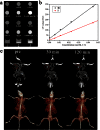Topological insulator bismuth selenide as a theranostic platform for simultaneous cancer imaging and therapy
- PMID: 23770650
- PMCID: PMC3683666
- DOI: 10.1038/srep01998
Topological insulator bismuth selenide as a theranostic platform for simultaneous cancer imaging and therapy
Abstract
Employing theranostic nanoparticles, which combine both therapeutic and diagnostic capabilities in one dose, has promise to propel the biomedical field toward personalized medicine. Here we investigate the theranostic properties of topological insulator bismuth selenide (Bi2Se3) in in vivo and in vitro system for the first time. We show that Bi2Se3 nanoplates can absorb near-infrared (NIR) laser light and effectively convert laser energy into heat. Such photothermal conversion property may be due to the unique physical properties of topological insulators. Furthermore, localized and irreversible photothermal ablation of tumors in the mouse model is successfully achieved by using Bi2Se3 nanoplates and NIR laser irradiation. In addition, we also demonstrate that Bi2Se3 nanoplates exhibit strong X-ray attenuation and can be utilized for enhanced X-ray computed tomography imaging of tumor tissue in vivo. This study highlights Bi2Se3 nanoplates could serve as a promising platform for cancer diagnosis and therapy.
Figures




 ) or Iopamidol (
) or Iopamidol ( ) as function of the concentration. (c) CT coronal views of a mouse following an intratumoral injection of 100 μl of Bi2Se3 nanoplates solution (0.2 mol Bi l−1) (top). The corresponding 3D rendering of in vivo CT images above (bottom). The position of tumor is marked by red circles.
) as function of the concentration. (c) CT coronal views of a mouse following an intratumoral injection of 100 μl of Bi2Se3 nanoplates solution (0.2 mol Bi l−1) (top). The corresponding 3D rendering of in vivo CT images above (bottom). The position of tumor is marked by red circles.
Similar articles
-
Improving the photothermal therapy efficacy and preventing the surface oxidation of bismuth nanoparticles through the formation of a bismuth@bismuth selenide heterostructure.J Mater Chem B. 2020 Oct 7;8(38):8803-8808. doi: 10.1039/d0tb00825g. J Mater Chem B. 2020. PMID: 32857100
-
CD47-targeted bismuth selenide nanoparticles actualize improved photothermal therapy by increasing macrophage phagocytosis of cancer cells.Colloids Surf B Biointerfaces. 2019 Dec 1;184:110546. doi: 10.1016/j.colsurfb.2019.110546. Epub 2019 Oct 3. Colloids Surf B Biointerfaces. 2019. PMID: 31606701
-
Hydrophilic graphene oxide/bismuth selenide nanocomposites for CT imaging, photoacoustic imaging, and photothermal therapy.J Mater Chem B. 2017 Mar 7;5(9):1846-1855. doi: 10.1039/c6tb02137a. Epub 2017 Feb 17. J Mater Chem B. 2017. PMID: 32263924
-
The versatile biomedical applications of bismuth-based nanoparticles and composites: therapeutic, diagnostic, biosensing, and regenerative properties.Chem Soc Rev. 2020 Feb 21;49(4):1253-1321. doi: 10.1039/c9cs00283a. Epub 2020 Jan 30. Chem Soc Rev. 2020. PMID: 31998912 Review.
-
Novel Bismuth-Based Nanomaterials Used for Cancer Diagnosis and Therapy.Chemistry. 2018 Nov 27;24(66):17405-17418. doi: 10.1002/chem.201801588. Epub 2018 Oct 1. Chemistry. 2018. PMID: 29876975 Review.
Cited by
-
Internalization: acute apoptosis of breast cancer cells using herceptin-immobilized gold nanoparticles.Breast Cancer (Dove Med Press). 2015 Feb 10;7:51-8. doi: 10.2147/BCTT.S69834. eCollection 2015. Breast Cancer (Dove Med Press). 2015. PMID: 25709498 Free PMC article.
-
Photodynamic therapy at ultra-low NIR laser power and X-Ray imaging using Cu3BiS3 nanocrystals.Theranostics. 2018 Oct 21;8(19):5231-5245. doi: 10.7150/thno.25286. eCollection 2018. Theranostics. 2018. PMID: 30555543 Free PMC article.
-
Adaptable surfactant-mediated method for the preparation of anisotropic metal chalcogenide nanomaterials.Sci Rep. 2018 Feb 12;8(1):2860. doi: 10.1038/s41598-018-21328-7. Sci Rep. 2018. PMID: 29434252 Free PMC article.
-
Strongly Confined Bi2Se3 Quantum Dots via Pulsed Laser Ablation in Liquids.ACS Omega. 2025 May 29;10(22):23214-23221. doi: 10.1021/acsomega.5c01222. eCollection 2025 Jun 10. ACS Omega. 2025. PMID: 40521537 Free PMC article.
-
Luminescent zinc(ii) selone macrocyclic ring.RSC Adv. 2019 May 14;9(26):14841-14848. doi: 10.1039/c9ra01819k. eCollection 2019 May 9. RSC Adv. 2019. PMID: 35516307 Free PMC article.
References
-
- Cancer [homepage on the Internet]. Geneva: World Health Organization. Accessed January 15, 2013. Available from: http://www.who.int/cancer/about/facts/en/.
-
- Funkhouser J. Reinventing pharma: the theranostic revolution. Curr. Drug Discovery 2, 17–19 (2002).
-
- Davis M. E., Chen Z. G. & Shin D. M. Nanoparticle therapeutics: an emerging treatment modality for cancer. Nat. Rev. Drug Discovery 7, 771–782 (2008). - PubMed
-
- Petros R. A. & DeSimone J. M. Strategies in the design of nanoparticles for therapeutic applications. Nat. Rev. Drug Discovery 9, 615–627 (2010). - PubMed
Publication types
MeSH terms
Substances
LinkOut - more resources
Full Text Sources
Other Literature Sources
Miscellaneous

